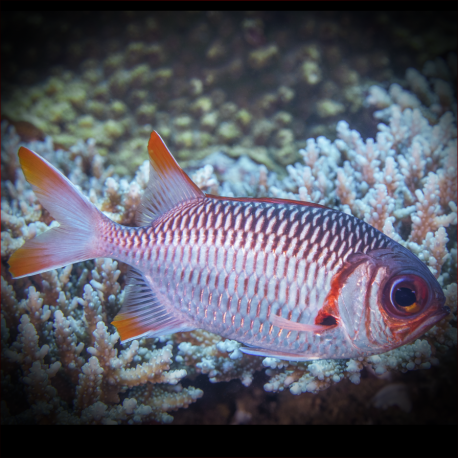More info
Datasheet
| Minimum Tank Size | 600 litres / 158.50 US gallons |
| Maximum Size | 35.0cm / 13.78inches |
| Reef Compatible | Reef safe with caution |
| Temperament | Mostly peaceful but might be aggressive towards similar species |
| Temperature | 22.2°C / 71.96°F - 25.6°C / 78.08°F |
| Specific Gravity | 1.020-1.025 |
| Carbonate Hardness | 8-12 |
| pH | 8.1-8.4 |
General Description: The Lattice Soldierfish, scientifically known as Myripristis violacea, is part of the Holocentridae family. This species can grow up to 35.0 cm in size and is native to the vast waters of the Indo-Pacific region.
Aquarium Suitability: Considered suitable for aquariums, this species requires caution due to its potential aggressiveness towards smaller fish and crustaceans. When catching the Lattice Soldierfish, it is essential to handle them carefully to avoid damaging their large eyes.
Demands, Care and Hardiness: Known for their hardiness, these fish are relatively easy to care for in a home aquarium setup. They prefer dimmed light initially, as they are nocturnal creatures and tend to be most active in low-light conditions. It's essential to provide hiding spots such as caves and overhangs to keep them comfortable.
Reef Suitability: While they are considered reef safe with caution, the Lattice Soldierfish may exhibit territorial behavior towards similar species in a reef environment.
Aquarium Setup: To accommodate Lattice Soldierfish, a tank size of at least 600 liters is recommended. Create a habitat that mimics their natural environment with dim lighting, ample hiding spaces, and a rocky setup to replicate their preferred rocky hiding spots in the wild.
Behaviour: These fish are mostly peaceful but can display aggression towards their own kind if space is limited. They are secretive in nature, tending to hide among rocks in the aquarium, especially when they feel threatened or stressed.
Feeding and Diet: The diet of the Lattice Soldierfish consists of fish, larger crustaceans, other invertebrates, and small crustaceans such as krill, mysis, and artemia. When acclimating them to a new environment, it may be necessary to start with live food to entice them to eat.
Habitat and Distribution: In the wild, these fish are found throughout the Indo-Pacific region, from East Africa to the Tuamoto Islands. Their natural habitat includes rocky areas with overhangs and caves where they seek shelter and protection.
Dimorphism: Not specified.
Captive Reproduction: Not specified.

